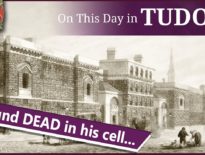On this day in Tudor history, 20th December 1583, the day after his son-in-law, John Somerville, had been found dead in his cell, Warwickshire gentleman Edward Arden was hanged, drawn and quartered at Smithfield.
Arden, who was related to William Shakespeare's mother, Mary Arden, and married to a member of the Throckmorton family, had been found guilty of treason, after being implicated in Somerville's plot to kill the queen.
But was Arden actually guilty? Why didn't others involved end up being executed too?
Find out more about Edward Arden and what happened in 1583, in today's talk.
Also on this day in Tudor history, 20th December 1541, a “very sickly” Agnes Tilney, Dowager Duchess of Norfolk, begged King Henry VIII for forgiveness. The dowager duchess had been arrested and taken to the Tower accused of misprision of treason for hiding her stepgranddaughter Catherine Howard's past relationship with Francis Dereham. Find out what she wrote to the king, and what happened to her, in last year’s video:
Also on this day in history:
- 1558 – Death of John Holyman, Bishop of Bristol and Rector of Hanborough in Oxfordshire. He was buried at Hanborough Church, in the chancel.
- 1559 – Burial of John Bekinsau (Beckinsau), scholar and theologian, at Sherborne St John in Hampshire. Bekinsau was the author of the 1546 tract De supremo et absoluto regis imperio in support of Henry VIII's supremacy.
- 1562 – Death of Margaret Kitson (other married name Bourchier and née Donnington), Countess of Bath. She was buried at the church in Hengrave, near Bury St Edmunds in Suffolk, which was near Hengrave Hall, the Kitson family seat. Margaret was the second wife of merchant adventurer Sir Thomas Kitson.
- 1571 – Death of Richard Butler, 1st Viscount Mountgarret and son of Piers Butler, 1st Earl of Ossory and 8th Earl of Ormond. He was buried in St Canice's Cathedral, Kilkenny city.
- 1606 – Death of Richard Reynolds (Rainolde), clergyman and author, in Essex. His work included the 1563 “ A booke called the foundacion of rhetorike, because all other partes of rhetorike are grounded thereupon” and “ A chronicle of all the noble emperours of the Romaines … setting forth the great power, and devine providence of almighty God, in preserving the godly princes and common wealthes” (1571).
Transcript:
20 December
Yesterday, I talked about the death of conspirator, John Somerville, on 19th December 1583, a man who was said to have committed suicide after being found guilty of treason for conspiring to kill Queen Elizabeth I. He wasn’t the only person to have been condemned for high treason for that alleged conspiracy, his father-in-law, Edward Arden was also found guilty, and, on this day in Tudor history, 20th December 1583, was hanged, drawn and quartered at Smithfield and his head displayed on London Bridge along with Somerville’s.
I’ll give you a link to yesterday’s video, but, today, let me tell you more about Edward Arden and his involvement in the conspiracy…
• Edward Arden was born in around 1532/1533 and was the son of William Arden from Warwickshire, a second cousin of William Shakespeare’s mother, Mary Arden.
• In 1545, Edward became his grandfather Thomas’s heir following the death of his father, William. His grandfather died in 1563 and Edward inherited Park Hall in Warwickshire, an estate which is now in the West Midlands rather than Warwickshire. There, as a Catholic recusant, he kept a Catholic priest, Hugh Hall, who was disguised as a gardener.
• Edward was married to Mary Throckmorton, daughter of Sir Robert Throckmorton of Coughton Court, and his first wife, Muriel Berkeley. The couple had three children: Robert, Margaret and Katherine. Their daughter Margaret married John Somerville, the man I talked about yesterday.
• In 1575, Edward served as sheriff of Warwickshire.
• Edward did not get on with fellow Warwickshire landowner, Robert Dudley, Earl of Leicester. He refused to wear his livery, he refused to sell property to him, and he made disparaging remarks about the earl and his marital history. Not a great idea when that earl is close to the queen!
• In October 1583, Edward’s son-in-law, John Somerville, who appears to have been mentally ill, was arrested after he had spoken of his intention to shoot and kill the queen. It is said that during interrogations on 31st October Somerville implicated Edward by saying that he was inspired to assassinate Elizabeth I when he heard Edward’s priest speak against the queen in front of him and Edward. This led to Edward’s arrest and imprisonment in the Tower of London, which he was taken to on 7th November.
• At a trial on 16th December 1583, Somerville pleaded guilty to treason, while Edward, his wife, Mary, and their priest, Hugh Hall, pleaded innocent. They were all found guilty.
• On the night of 16th December, after bribing the Lieutenant of the Tower’s servant, Edward was able to have a last meal with his wife.
• On 19th December 1583, Edward and Somerville were transferred to Newgate Prison, where Somerville was found dead in his cell just hours after their arrival. It was claimed that his death was suicide.
• On this day in Tudor history, 20th December 1583, Edward Arden suffered a full traitor’s death at Smithfield. The heads of Edward and Somerville were displayed on London Bridge as a warning of the fate of traitors, and their remains buried at Moorfields.
• Edward’s wife and priest were spared.
• As a traitor, Edward’s property was confiscated by the Crown, but his son, Robert, did manage to regain much of it later.
• Edward’s biographer, William Wizeman, notes that his contemporaries found the case against him suspicious and blamed it on the Earl of Leicester’s vengeance. Wizeman writes “The dropping of charges against the other defendants and the releasing of Mary Arden only made it more likely that he was the victim of a grave iniquity.”



There is a good bit on the Arden Plott in the Michael Wood series and book on William Shakespeare, it really hit at the heart of the Warwickshire countryside.
I think poor John Somerville was mentally ill or an alcoholic because you wouldn’t really boast that you were planning to kill the Queen in public if you were, certainly not in a world in which you could end up being hanged drawn and quartered for your trouble. He must have been overwhelmed with the fear and the confinement or he was killed. It was rather nasty sticking his head up on a stake anyway, as he was already dead.
Edward Arden was involved in some dodgy deals as well and was implicated in this plot as the main conspirator who was executed. However, several homes connected to the Arden family were searched and it came very close to Mary’s family, themselves. I suspect the Earl of Leicester invented it out of revenge.
a